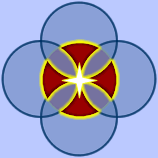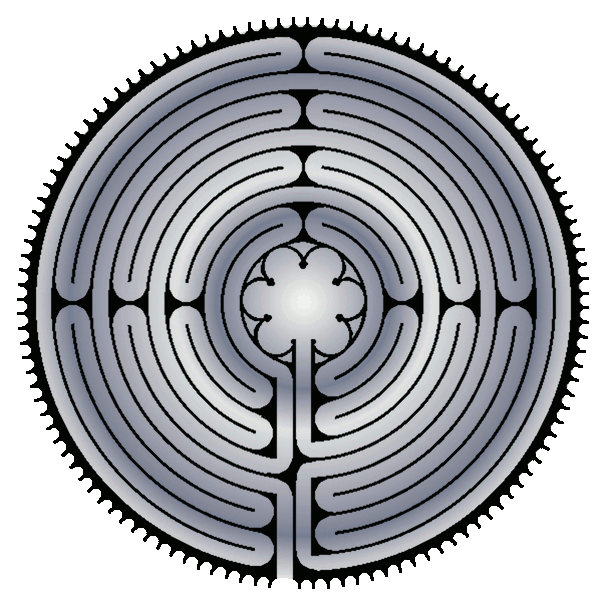

 |
Chartres Secrets |
 |

|
One of the best examples of a Medieval Pavement Labyrinth can be found in the west side of the nave in Chartres Cathedral in France. Constructed around the beginning of the 13th century, and widely used as an open-eyed, activity meditation tool, it is an integral part of any visit to this church. Such a labyrinth is not to be confused with a maze. A maze is a deliberately confusing intricate network of passages, often leading to a state of bewilderment. It is like a puzzle that must be solved by thinking your way through the false paths and dead ends. It stimulates your mental thought process. In contrast, a labyrinth, such as this, is an easy to follow, meandering, spiraling, circular path, leading to and from the center. There is only one path inwards, and then, by reversing, the same path leads back out again. It becomes for you, a spiritual journey on many levels, leading you inward to your own center, and then back out into the mundane world. It stimulates your creativity, inspiration, and intuition. Once, there were many such labyrinths in other Gothic cathedrals throughout Europe. Smaller versions were often found in tiles or carvings on the wall of the church near the entrance. Here, a visitor would "walk the labyrinth" with their hand or fingers. Many of these other labyrinths have been destroyed or removed, and this enhances even more, the precious value of the Chartres Labyrinth. Going beyond the more classical seven- circuit Cretan labyrinth, the Medieval Chartres Labyrinth is an eleven-circuit design, dived into four quadrants, and encircled by an outer ring of lunations. It is about 42 feet or 12.9 meters in diameter, and the walk in to the center and back out again is a distance of about one third of a mile. The lunations have been thought by some to represent a type of lunar calendar that was used to determine the date of Easter each year. The 112 lunations would represent 4 lunar months of 28 days. The quadrants bring to mind the even armed cross. The spiritual center goal, the resting place, is defined by a Rosette pattern of 6 petals, reminiscent of the sacred lotus, symbol of Enlightenment. In the Medieval Christian churches, the labyrinths are often thought to be designed as a symbolic pilgrimage to the Holy Land. One journeyed to the center and there a variety of experiences could occur. One often came away with feelings of great peace, joy, love, serenity, forgiveness, and inspiration. The experience was sometimes used as a form of repentance when the pilgrims would walk the labyrinth route on their knees. Some scholars believe that the Chartres Labyrinth formed a part of a special liturgy for Easter each year, when the Dean of the Cathedral would lead the congregation on the labyrinth path to the center of the “New Jerusalem”, and then reemerge in a symbolic Dance of Resurrection. The Chartres Labyrinth is enhanced by the powerful telluric energies flowing and converging beneath this Cathedral. Today, many models of this labyrinth are produced on canvas or through carvings. However, nothing can compare to actually standing in the center of the Chartres Labyrinth in France! The Chartres Labyrinth area is often hidden or covered by rows of chairs, but the opportunity to walk this sacred journey as it was originally intended is a wondrous experience. Even to walk up the Aisle and pause for a prayer in the Labyrinth’s center Rosette, is a consciousness expanding experience, not to be missed. The Chartres Sacred Tours that are offered through this site may include a specific ancient activity meditation that would enhance your Chartres Labyrinth experience. |

© 2008 Chartres Secrets
All Rights Reserved